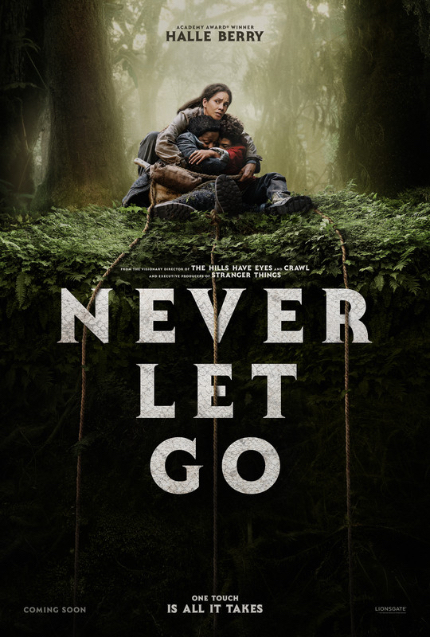NEVER LET GO Review: Halle Berry Lends Her Oscar-Winning Bonafides to Post-Apocalyptic Thriller

A founding member of the “New Extremity” movement that brought French horror filmmakers to the attention of international audiences in the early oughts, writer-director Alexandre Aja (Oxygen, The 9th Life of Louis Drax, Haute Tension) parlayed his fearless, uncompromising approach to the horror genre into a filmmaking career into an international career outside of his native France.
Beginning with a promising collaboration with Wes Craven, the 1976 remake of The Hills Have Eyes, through middling efforts (Mirrors, Maniac, Horns) and the one-off standout, Piranha 3D, Aja overcame mid-career stagnancy with Crawl, a bloody, gory, pulpy “animals amok” eco-horror.
Aja’s latest horror film, Never Let Go, shifts the setting from the alligator-filled, riverside Florida town of Crawl or the terrors of outer space in Aja’s last film, Oxygen, to a post-apocalyptic forest somewhere in the Deep South and the three inhabitants, an unnamed woman (Halle Berry) identified only as “Momma,” and her fraternal twin sons, Samuel (Anthony B. Jenkins) and Nolan (Percy Daggs IV), as they attempt to survive an amorphous evil enveloping the forest, dwindling supplies, and the mother’s increasingly paranoid, disturbed behavior.
Survival in the unnamed forest involves a specific set of rituals, including but not limited to the ropes connected to the cabin the woman and her sons use every day whenever they venture out to forage for food. Each day, they pray before and after leaving their home, a potent reminder of the plague-like, supernatural evil awaiting them if they lose contact with the home. A door leading into a crawlspace doubles as a location for meditation and contemplation of the evil outside and the mental, and spiritual fortitude necessary to keep it perpetually at bay.
Of her two sons, the dutiful Samual accepts Momma’s stringent rules without hesitation or doubt, while Nolan, more curious by nature, begins to openly question Momma’s stories about a fallen world overrun by evil and whether Momma, Samuel, and Nolan are all that’s left of humanity. Initially kept in the background to simmer, Samuel and Nolan’s differing views toward their mother and the world outside foreshadow not just a breakdown in their relationship, but an irrevocable, life- and narrative-altering break too.
Working from a densely layered, taut screenplay credited to Kevin Coughlin and Ryan Grassby, Aja methodically doles out the rules and lore behind Never Let Go’s claustrophobic world in the first act before undermining them in the second. An accidental slip and fall down an embankment leaves Samuel briefly untethered from his rope. Also untethered, Nolan follows almost immediately to help his brother before Momma, still connected to her rope, saves them, moments before the evil hiding in the forest reveals itself.
Only Momma, however, can see the manifestation of evil, a hissing, ink-stained wretch with a forked tongue, raising doubts not just about the supernatural evil that supposedly represents an existent threat and whether it, in fact, exists, but practically everything else, from the stories of a fallen world without human survivors beyond Momma, Samuel, and Nolan, to the exhaustive rules that dictate their every waking moment and keep Samuel and Nolan literally, figuratively, and emotionally bound to their mother.
Metaphorically, Momma’s fear- and anxiety-driven behavior represents a parent’s protective instincts against a dangerously frightening world taken to a literal extreme (the ties that bind, etc.). Ultimately, though, Never Let Go turns less on Momma’s potentially realty-distorting behavior than on Samuel and Nolan, products of home-schooling dictated by fervently apocalyptic world view, react when confronted with variables outside their indoctrination. Hint: It goes about as badly as expected.
For all of Aja’s expert tension-building throughout, Never Let Go falters when confronted with answering the central mystery and whether to answer it definitively or leave the mystery unanswered. On its own, ambiguity isn’t necessarily a problem, but Aja and his screenwriters chose both to answer the mystery seconds before the end credits roll while also leaving it frustratingly vague and ill-defined. There’s no how or why or even when, just reliance on a horror audience’s goodwill that might prove unfounded and misplaced in the end.
Luckily, Never Let Go benefits from strong performances, a given where Oscar-winner Berry might be concerned, but not necessarily where non-adult actors are. Both Jenkins and Daggs deliver uniformly strong, persuasive performances as Samuel and Nolan, respectively. Add well-thought-out production design, restrained, classical camerawork from Aja’s frequent collaborator, Maxime Alexandre, and unobtrusive editing, and the result, while certainly flawed, rarely falls below engaging or entertaining territory.
Never Let Go opens today, only in movie theaters, via Lionsgate. Visit the official site for locations and showtimes.







